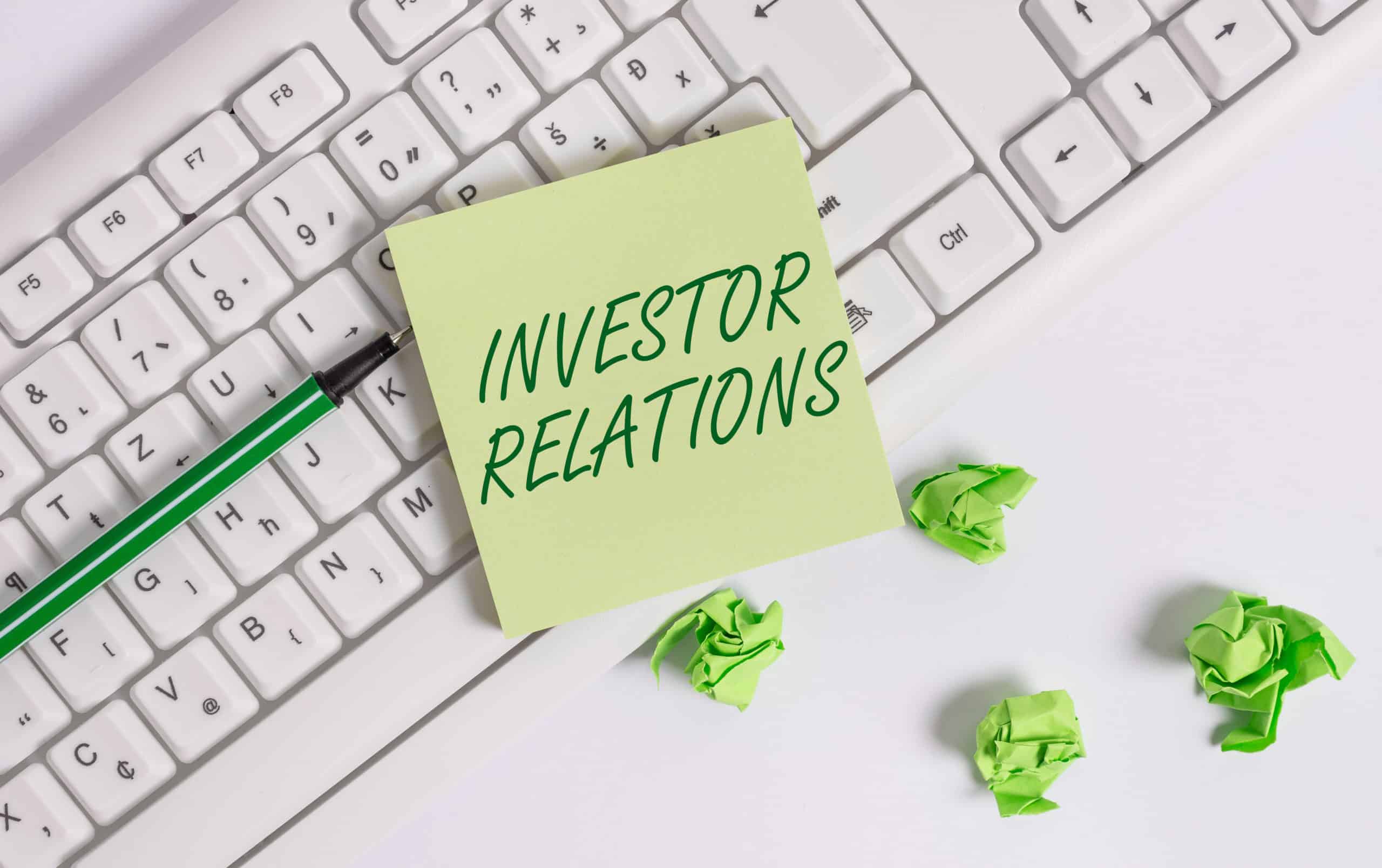We continue to see confusion among businesses and investors about what sustainable investing, impact, and ESG really entail – and what the difference is between them.
ESG is not a “movement” or a cause-related initiative, it’s a system by which companies can measure and report on Environmental, Social, and Governance factors that affect their business. It’s about identifying risk and opportunity so that management and all stakeholders can better understand the state of – and the future of – the business. Effective ESG Reporting helps companies set goals and communicate about their findings and progress.
We spoke about how ESG and Investor Relations work together with Maureen Wolff, CEO of Sharon Merrill, an IR strategic advisory firm with an international reputation for creating optimal value for stakeholders. Maureen is an accomplished visionary in the fields of investor relations and corporate communications with more than 35 years of success counseling C-level executives and directors to raise the level of their communications, build credibility and maximize shareholder value. She has earned a reputation for providing clients with stellar advice on implementing best-in-class Environmental, Social and Governance (ESG) strategies; navigating proxy contests and activism campaigns; elevating proxy communications; raising capital and developing crisis communication strategies.
Good to speak with you, Maureen. Which do you think is the more common driver for ESG reporting: formal investor demand or an organic embrace of sustainability at the corporate level?
We believe it is both. We’re seeing widespread investor demand as a recent catalyst, coupled with genuine and organic interest in ESG matters from forward-thinking and conservative companies alike. More companies today are purpose-led and see the value for their business strategy of having greater action and impact on areas such as the environment, their people, their customers and communities. These companies also increasingly recognize the value of strong governance practices to help best prepare for potential challenges, to mitigate risks and to seize opportunities.
From the investor lens, ESG investing has proven its ability to outperform the market, mitigate risk, and align with values-led investing desires. Risk mitigation is a fiduciary duty. For funds with over a trillion dollars under management or those with long-term pension payment requirements and multi-generational planning timespans, the stakes are higher and the need to manage risk more profound. ESG actions and reporting serve those needs. Today, even small funds are seeing the value of understanding where companies stand in ESG as both the value, performance and retail investor demand has become apparent.
From the viewpoint of company leadership, the drive to more formally address and document ESG impact is the culmination of many influences and evolutionary changes adopted by the business world over the past few decades. Influences include employee and customer views on climate, social causes, purpose-based companies and positive impact; greater awareness on the business value of diversity and inclusion; new philosophies on the purpose of a corporation; activism on Board Governance; ESG-focused capital; M&A valuations; and other leading companies boldly and publicly announcing major, time-based sustainability goals. Factors such as these are converging as part of the business fabric of the 21st Century to naturally influence ESG within business processes. Purpose and results are now interwoven and becoming the norm.
In addition to the annual sustainability report, are more clients requesting help with ESG information in other investor communications?
Yes, companies are now incorporating ESG content into areas such as websites, corporate overviews, company infographics, earnings calls, proxies and other SEC filings, recruiting literature, and customer-facing materials. A best practice is for companies to weave the ESG narrative into the very core of how the company presents itself and manages its operations. Studies have shown it is now becoming a competitive disadvantage and a drag on valuation for companies that are not addressing ESG factors in their materials and philosophies.
What’s different in this era of COVID-19?
The COVID-19 pandemic is an example of a challenge that touched on each aspect of ESG. Financial results already are showing that thoughtfully deployed ESG strategies can help strengthen companies. Consider, for example, companies that were immediately able to support the health and wellness of their people; those that had the ability to help communities and local health systems with donations or services; those that had liquidity and financial reserves on hand; those with redundancy in their supply chain; and/or those that were fully prepared technically and culturally to have cyber-secure operations ready for full remote work. Advanced preparation for such sustainable business practices represent long-term thinking – from companies of all sizes. Even our smallest public company client was able to display ESG strengths. This client offered an emergency COVID-19 relief program for their customers, seamlessly adapted to remote work for the safety of their people and the sustainability of their revenue, and leveraged the access to capital they had put in place prior to this crisis.
During COVID-19, companies are showing themselves to be more resilient with ESG practices, and it has become inherently clearer why ESG is so critical.
What do you say to management teams who are hesitant to start an ESG program because it seems too overwhelming?
ESG is a journey. We show management teams that they already have accomplished certain steps in the journey. We then help the company focus its narrative on its natural strengths and alignment to initiatives most important to their business strategy and ESG stakeholder interests. We work with clients on an organized construct from which investors and other interested stakeholders can recognize and access key ESG content. Once the foundational aspects are in place, the journey becomes much easier to document and feature. Feedback from customers, employees, investors and other important stakeholders serve as positive indicators for management teams that the work is valued.
We also remind our clients that while a focus on the trillions of investment dollars geared to ESG-oriented companies could be a compelling motivator, the true win is the long-term business strength and risk mitigation that comes with genuine interest and action in the principals found in ESG.
How do you determine what areas of the company’s ESG efforts to focus on to make your ESG communications the most relevant for investors?
To help companies find the most relevant ESG categories for their investors, we generally begin with a review of the Sustainability Accounting Standards Board (SASB) materiality map aligned to the client company’s specific industry and offerings. From there, we review the client’s public documents and website for content that shows strength aligned to the most important factors to their stakeholders. Investors in healthcare companies, for example, place high importance on product quality and business ethics. We would ensure those are two areas for which the company has narrative, content, documentation and a further development plan as needed. We also would ensure those subjects are addressed in key corporate overviews, including the company’s website home page and general business overview.
How do you see investor interest in ESG evolving?
We see ESG influence expanding multi-fold and moving from a carrot to what could be a stick for those companies who have not, most notably, been attentive to the Governance portion of ESG.
The Big 3 — the passive index funds BlackRock, State Street and Vanguard – constitute the largest shareholder in 88 percent of the S&P 500 firms. The Big 3 are vocal in their commitment to ESG and are outright demanding companies step up, else they will vote against board members in elections.
Additionally, sell-side firms now are beginning to rate ESG for the companies they cover. Until recently, ESG ratings were a stealth overlay from a research arm of the investment house or third-party research firm not involved in the day-to-day coverage of companies. IR officers, CFOs and CEOs could do a conference circuit and not get a single ESG question. More sell-side analysts and portfolio managers now are regularly asking ESG-oriented questions to the companies they cover. Companies, at a minimum, need to know the basics such as where they stand on the SASB materiality map, have a narrative that reflects the investor concerns for their industry segment, be able to communicate their core strengths in ESG and articulate where the company is heading in the future to further build key strengths and shore up opportunities where they could be stronger, such as board diversity or reduction of greenhouse gas in their facilities.
Finally, Institutional Shareholder Services (ISS), Glass Lewis and Moody’s ratings are influencing Board composition, M&A valuations, and the cost of capital for public companies. The ROI from ESG initiatives is now evolving its definition to include Risk of Ignoring.
Notably, US SIF (Forum for Sustainable and Responsible Investing) will release this Fall its biennial report on the volume of investment assets in sustainable investing. In its last report, dated October 31, 2018, the US SIF reported that one in four investment dollars went to sustainable investing.
We believe this year’s report will show a dramatic spike in those results. Further, with ESG investing outperforming the greater market thus far in 2020 during the COVID-19 pandemic, we expect the results will only further this strong and important investment sea change.
Thanks for your time and insight, Maureen.
Learn more about our expertise in ESG communications on Longview’s Sustainability page.




